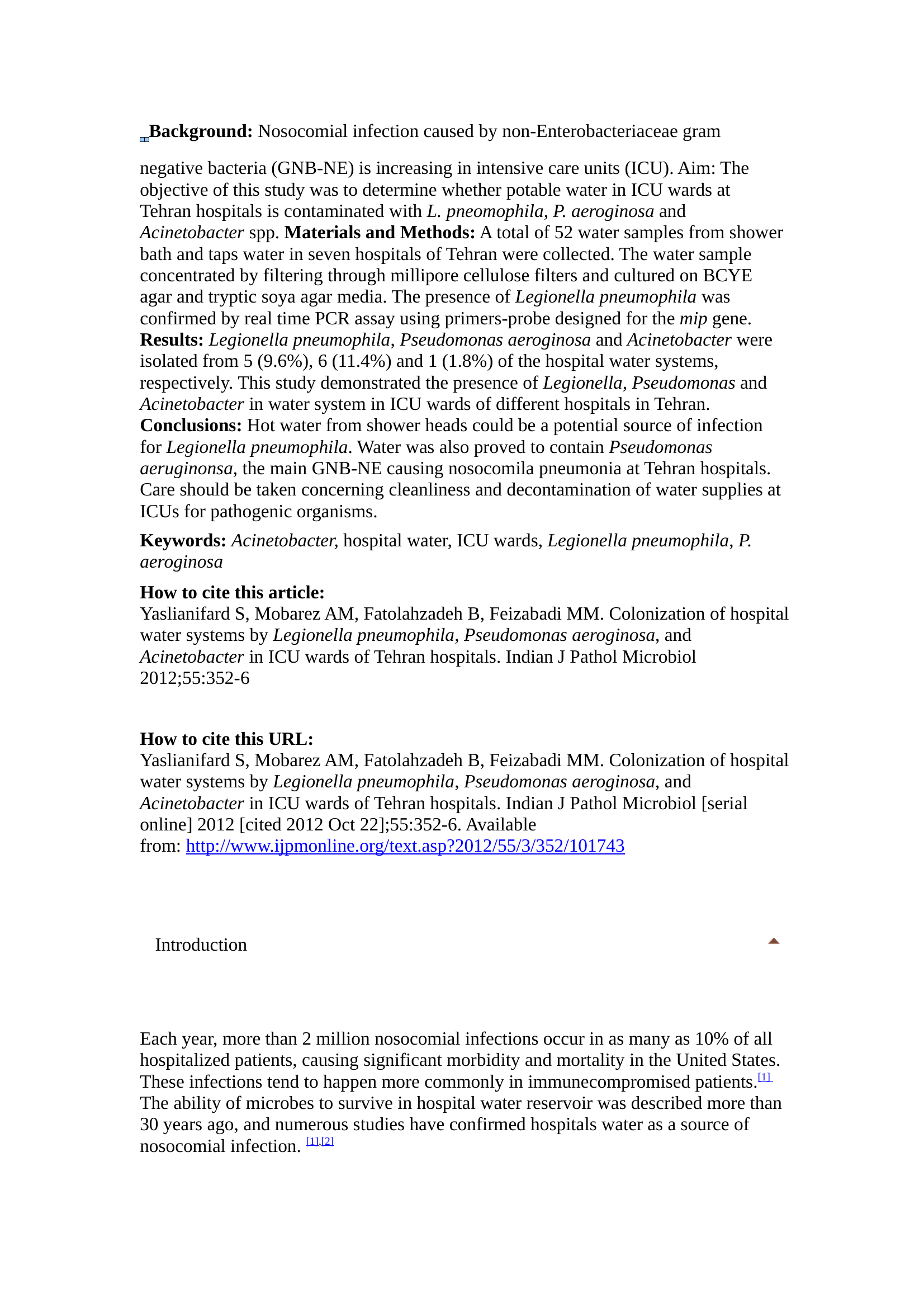Recherche scientifique
Publié le 12/11/2012

Extrait du document


«
Background: Nosocomial infection caused by non-Enterobacteriaceae gram
negative bacteria (GNB-NE) is increasing in intensive care units (ICU).
Aim: The
objective of this study was to determine whether potable water in ICU wards at
Tehran hospitals is contaminated with L.
pneomophila, P.
aeroginosa and
Acinetobacter spp.
Materials and Methods: A total of 52 water samples from shower
bath and taps water in seven hospitals of Tehran were collected.
The water sample
concentrated by filtering through millipore cellulose filters and cultured on BCYE
agar and tryptic soya agar media.
The presence of Legionella pneumophila was
confirmed by real time PCR assay using primers-probe designed for the mip gene.
Results: Legionella pneumophila , Pseudomonas aeroginosa and Acinetobacter were
isolated from 5 (9.6%), 6 (11.4%) and 1 (1.8%) of the hospital water systems,
respectively.
This study demonstrated the presence of Legionella, Pseudomonas and
Acinetobacter in water system in ICU wards of different hospitals in Tehran.
Conclusions: Hot water from shower heads could be a potential source of infection
for Legionella pneumophila .
Water was also proved to contain Pseudomonas
aeruginonsa , the main GNB-NE causing nosocomila pneumonia at Tehran hospitals.
Care should be taken concerning cleanliness and decontamination of water supplies at
ICUs for pathogenic organisms.
Keywords: Acinetobacter, hospital water, ICU wards, Legionella pneumophila , P.
aeroginosa
How to cite this article:
Yaslianifard S, Mobarez AM, Fatolahzadeh B, Feizabadi MM.
Colonization of hospital
water systems by Legionella pneumophila , Pseudomonas aeroginosa , and
Acinetobacter in ICU wards of Tehran hospitals.
Indian J Pathol Microbiol
2012;55:352-6
How to cite this URL:
Yaslianifard S, Mobarez AM, Fatolahzadeh B, Feizabadi MM.
Colonization of hospital
water systems by Legionella pneumophila , Pseudomonas aeroginosa , and
Acinetobacter in ICU wards of Tehran hospitals.
Indian J Pathol Microbiol [serial
online] 2012 [cited 2012 Oct 22];55:352-6.
Available
from: http://www.ijpmonline.org/text.asp?2012/55/3/352/101743
Introduction
Each year, more than 2 million nosocomial infections occur in as many as 10% of all
hospitalized patients, causing significant morbidity and mortality in the United States.
These infections tend to happen more commonly in immunecompromised patients.
[1]
The ability of microbes to survive in hospital water reservoir was described more than
30 years ago, and numerous studies have confirmed hospitals water as a source of
nosocomial infection.
[1] , [2].
»
↓↓↓ APERÇU DU DOCUMENT ↓↓↓
Liens utiles
- La recherche scientifique est elle une recherche de la vérité
- SYSTÈME DE LOGIQUE DÉDUC-TIVE ET INDUCTIVE, exposé des principes de la preuve et des méthodes de recherche scientifique
- La recherche scientifique.
- L'objectivité dans la recherche scientifique
- La recherche scientifique peut-elle se passer de théorie?










